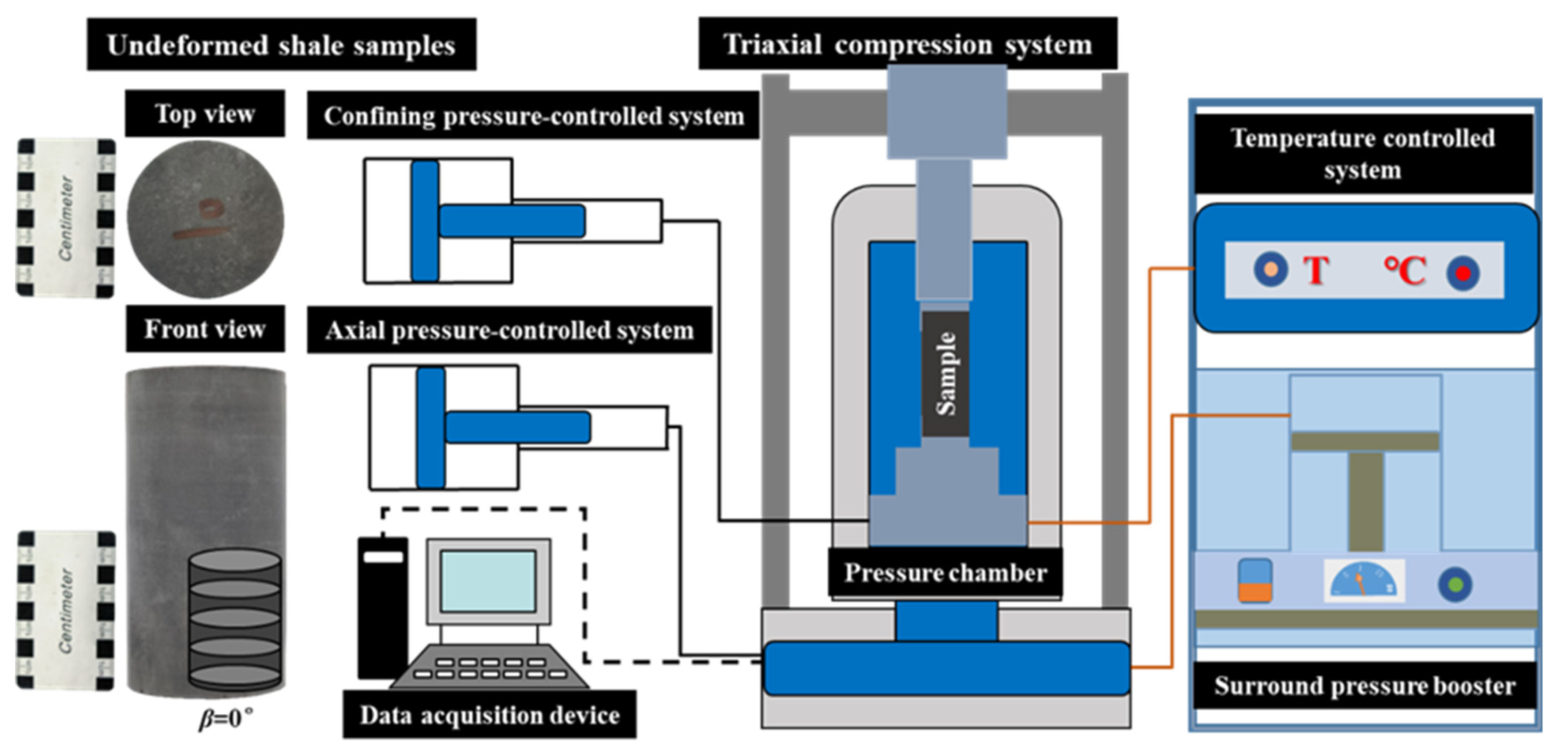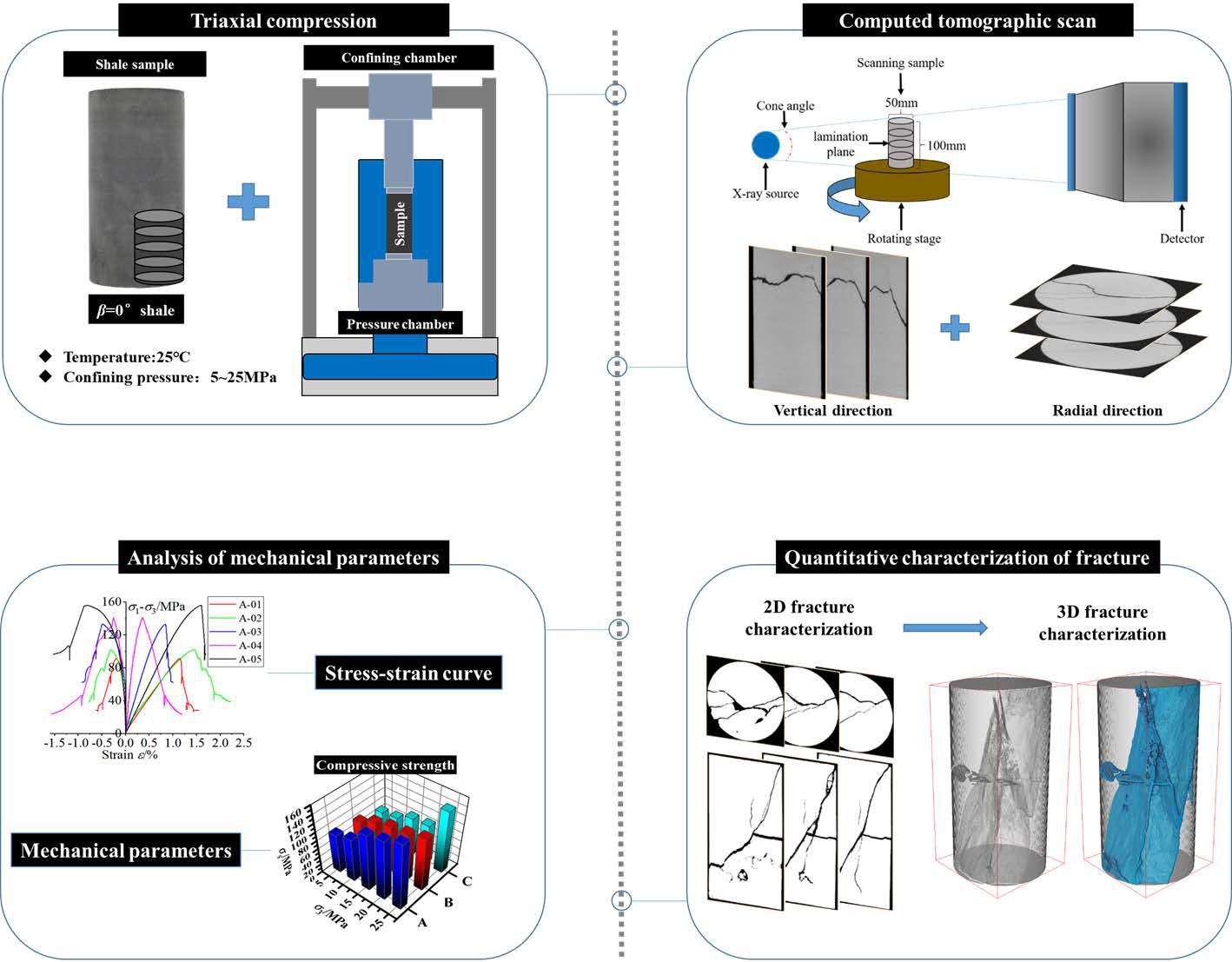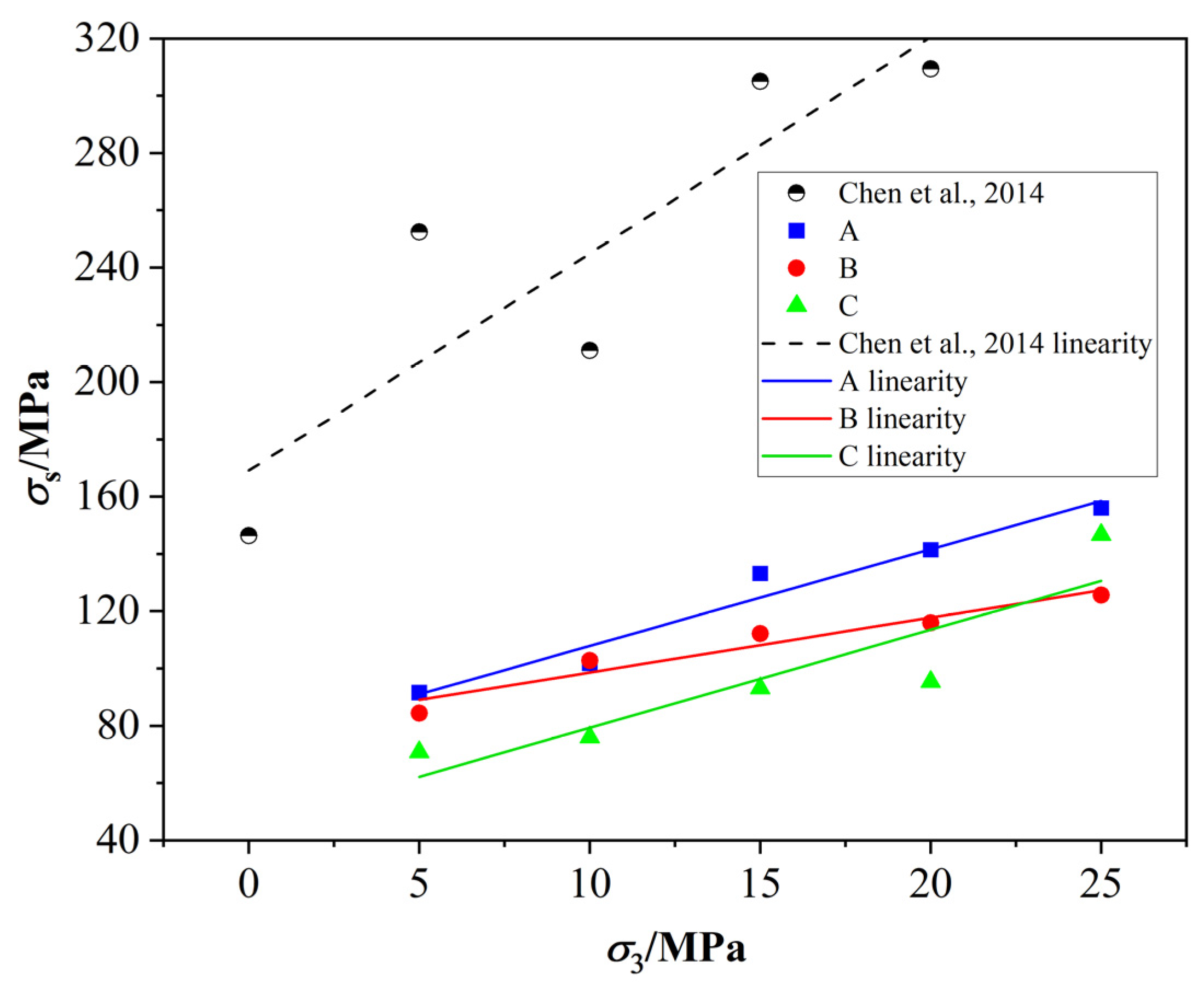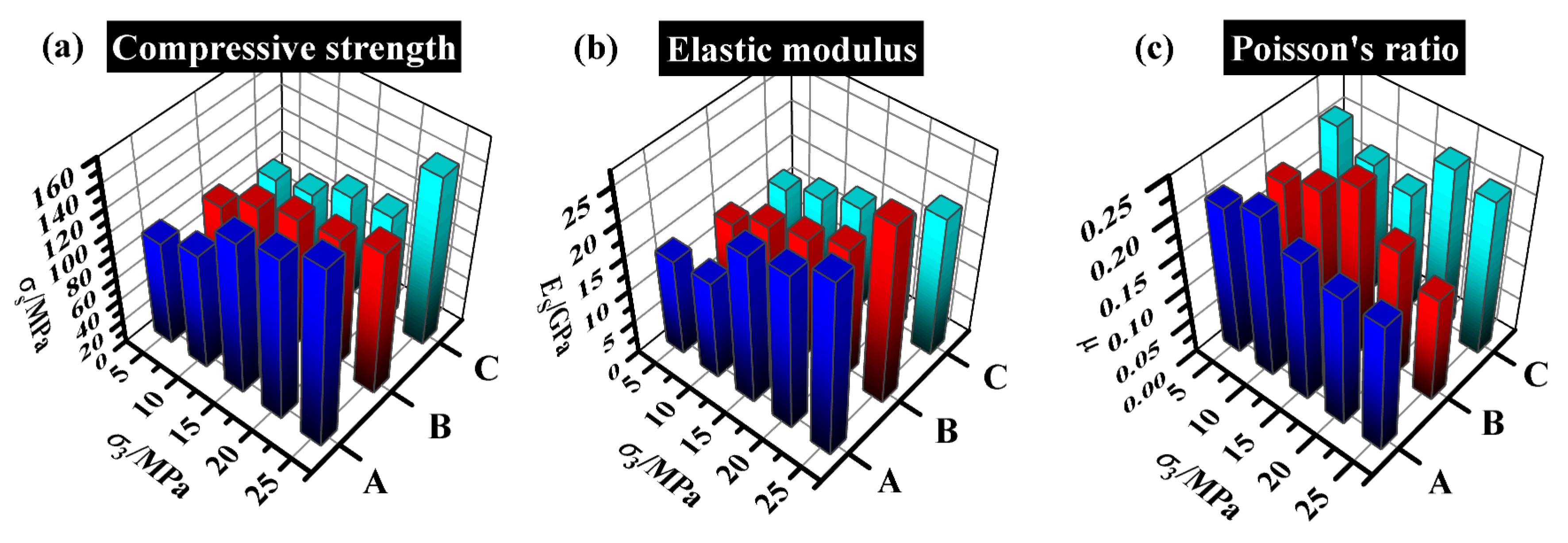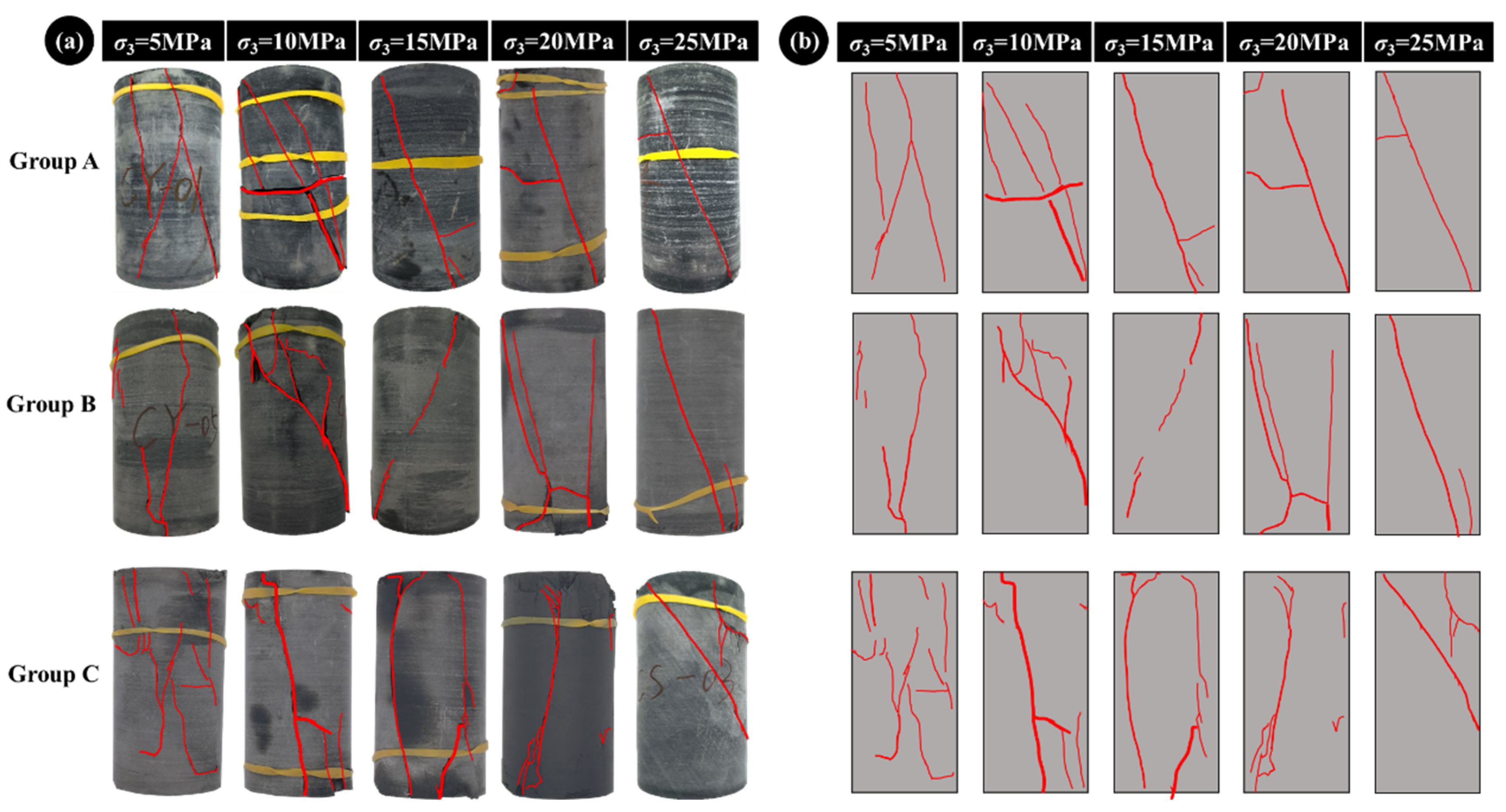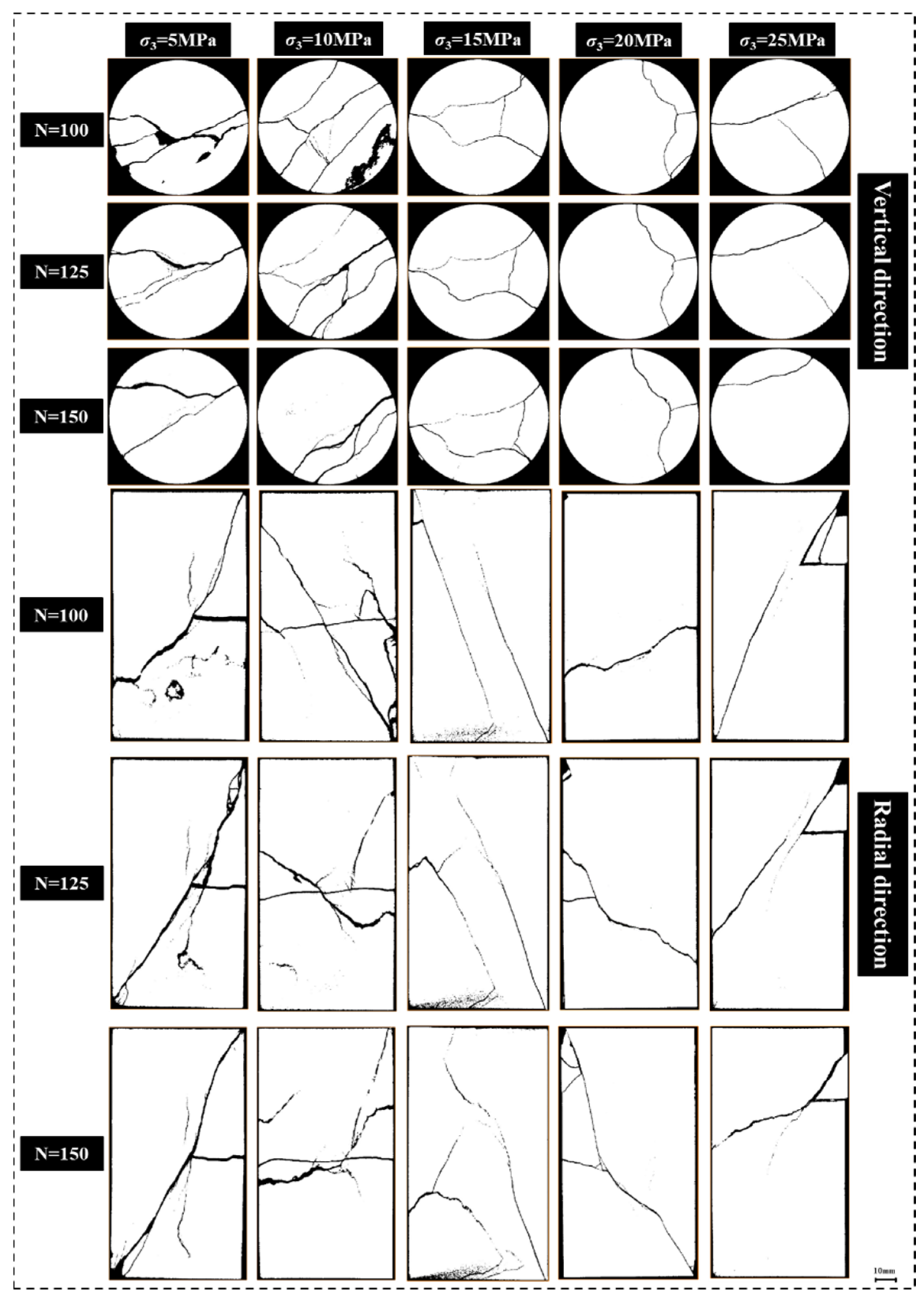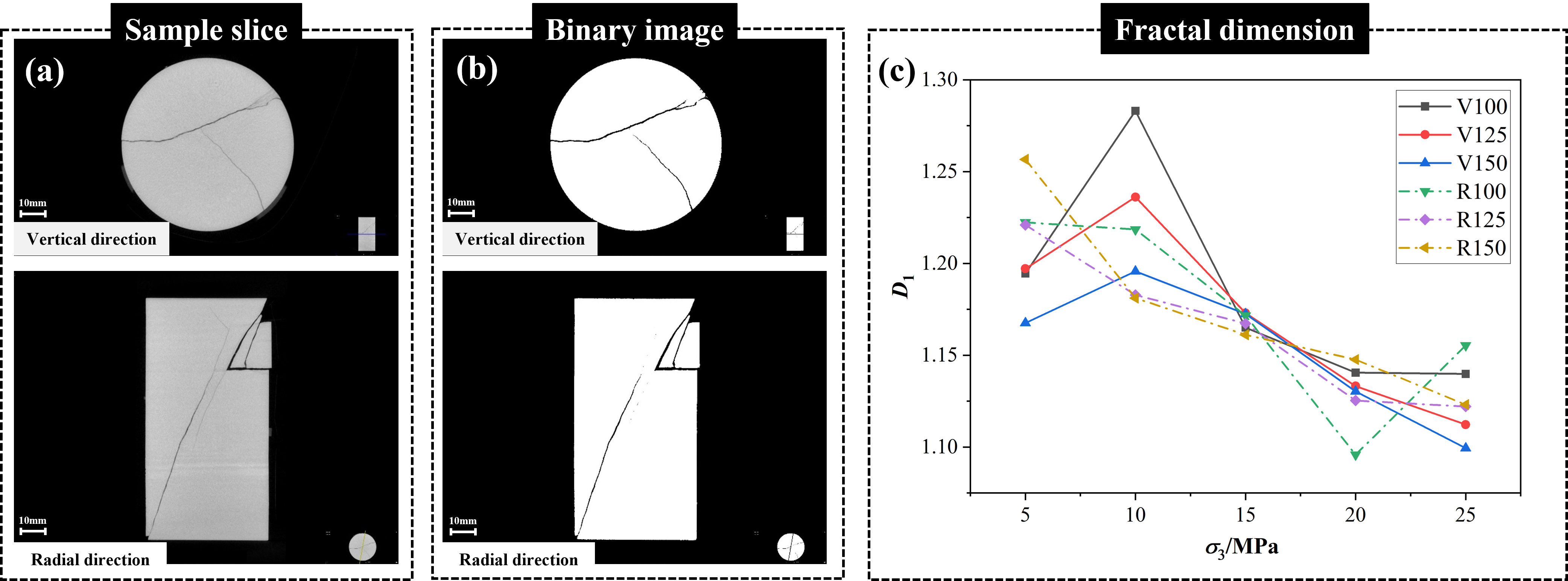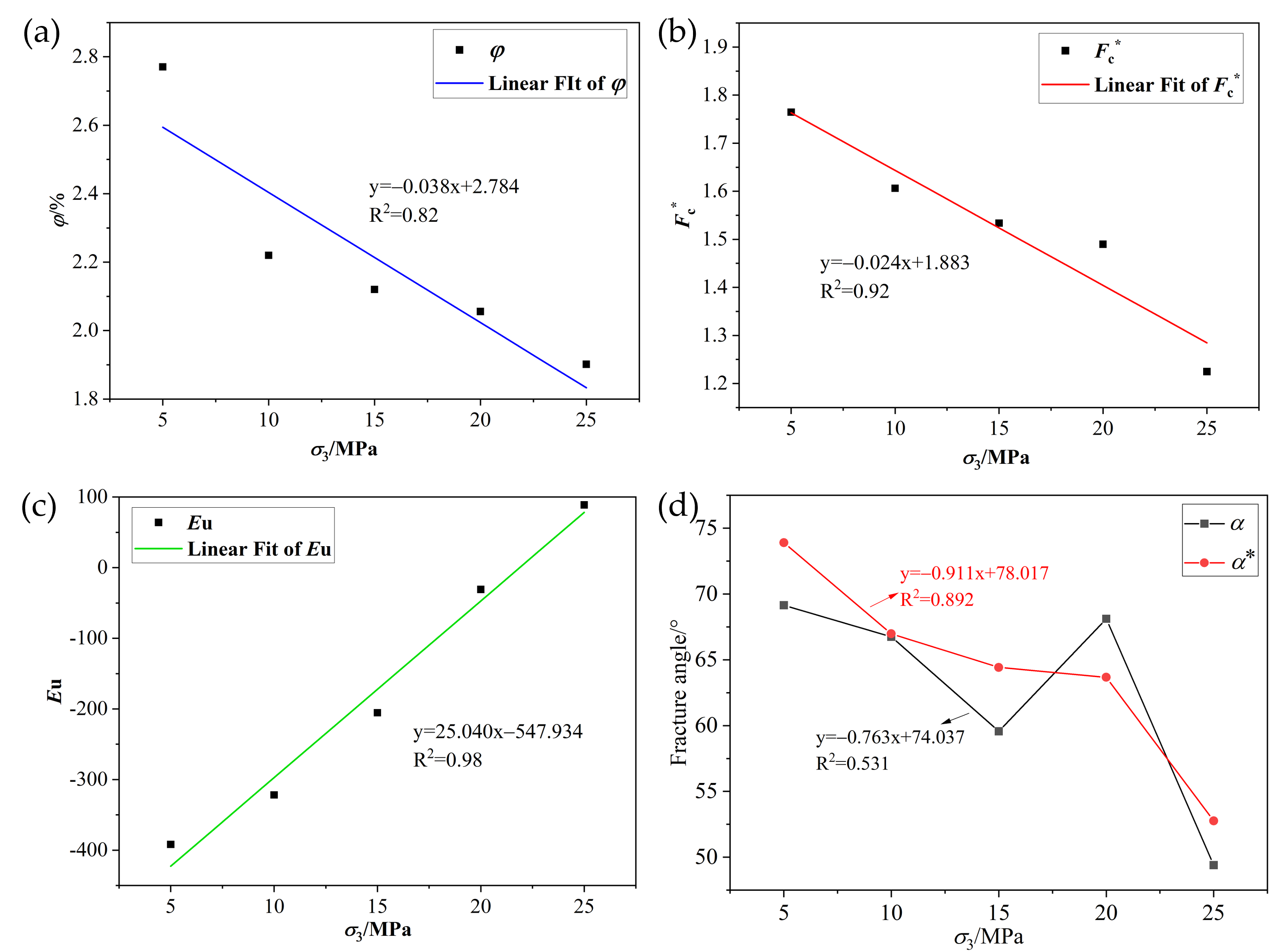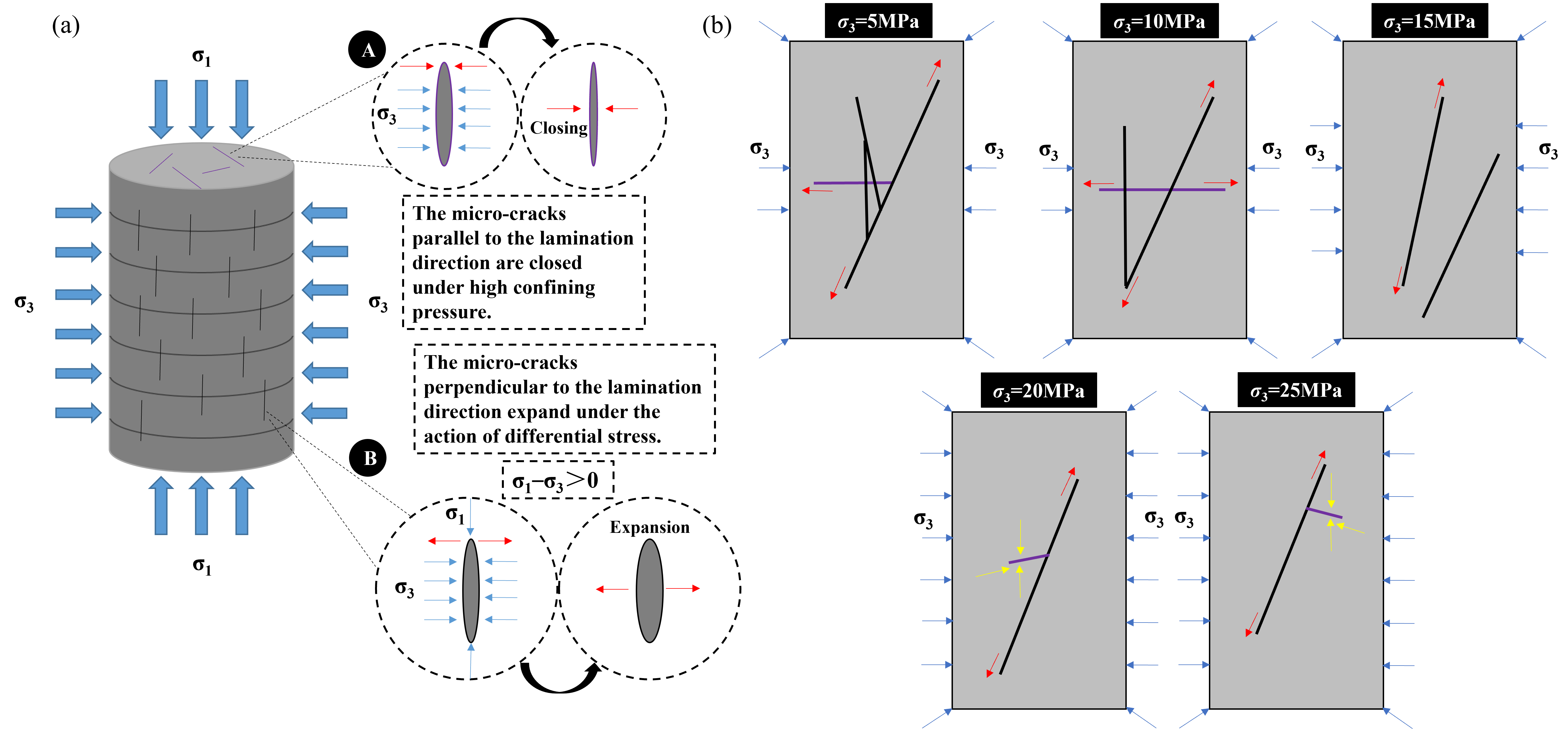3.4.1. 2D Fractal Dimension
The surface of the sample fractures is statistically characterized using the fractal theory [
20,
21] to better investigate the geometric morphology and distribution of fractures. The 2D fractal dimension is a strictly lower-than-2 number that is higher than 1. When typical geometric features (circles, broken lines, and straight lines) are used, the outcome is 1. Fractal dimension is a useful metric for measuring and comparing the degree of irregularity and fragmentation in 2D images at various magnifications. The curve’s ability to fill the space is another useful signal. The fractal dimension decreases with the increase in curve smoothness.
In this research, the box-counting fractal dimension method [
22,
23] was employed due to its relative ease of mathematical calculation and applicability for characterizing the spatial distribution of fractures. To determine the dimension of a fractal object or set
F, an evenly spaced grid cover is placed on the fractal, and the number of boxes needed to minimally cover it is counted. The variation in the number of boxes as the grid becomes finer is used to compute the box-counting fractal dimension. The following formula can be used to get the box-counting fractal dimension:
where
D1 is the box-counting fractal dimension,
δ is the side length of covering boxes,
F is the fractal set, and
Nδ(
F) is the number of boxes.
The axial load of the compression test is applied by raising the base of the apparatus, which will result in more severe damage along the top and bottom borders of the sample. The fracture distribution of the edge section is significantly inaccurate. Therefore, we selected the longitudinal and transverse slices of each sample numbered 100, 125, and 150 as the research object (these slices are closer to the central part of the sample) (
Figure 8). When the confining pressure is low (
σ3 < 15 MPa), the radial binarized image mostly displays the cross distribution of shear and tensile fractures in the sample. Sample fractures typically occur in a single shear condition at high confining pressures (
σ3 > 15 MPa). The distribution of fractures gradually becomes single, while the number of fractures in both longitudinal and radial directions steadily decreases with an increase in confining pressure.
It is in line with the previously discussed sample failure mode. Concurrently, a linear decreasing trend is observed in the relationship between the confining pressure and the 2D fractal dimensions in both directions, as shown in
Figure 9c. The physical definition of fractal dimension indicates that the form and distribution of fractures are more complicated the larger the fractal dimension. Therefore, it can be seen from the quantitative data that under low confining pressure, the distribution of axial slice fractures has no obvious law with the change in confining pressure. The complexity of radial slice fracture distribution decreases with the increase in confining pressure. The intricacy of the fracture distribution in both directions is inversely connected with the confining pressure at high confining pressures.
The average fractal dimensions of the three sets of slices in two directions are obtained to further evaluate the relationship between the confining pressure and the fractal dimension in the vertical and radial directions (
Figure 10). The findings show that when confining pressure increases, the fractal dimension reduces linearly in both directions. The failure modes in the vertical and radial directions also show obvious regular changes with the increase in confining pressure. The failure mode of the slice in
Figure 10 shows that the distribution pattern is more complex, the length is longer, and there are more fractures in both directions of the slice under low confining pressure. The interwoven occurrence of tensile and shear fractures characterizes the fracture morphology of radial slices under low confining pressure. The radial slice fracture morphology essentially shows a main shear fracture and a secondary fracture when the confining pressure is 20 MPa. When the confining pressure is 25 MPa, the fractures in both directions exhibit a single shear fracture, which is in line with the findings of the earlier research. The above analysis shows that the fractal dimension can accurately and quantitatively characterize the internal fracture changes of shale samples in two directions. In addition, the increase in confining pressure will not only affect its mechanical properties, but also greatly limit the expansion and development of radial fractures, resulting in the simplification of the whole fracture network.
3.4.2. 3D Fractal Dimension
The 3D visualization provides a more thorough observation of the geometric form and spatial distribution properties of fractures. The 3D fractal dimension of the 3D rebuilt fracture model is computed using the box dimension method [
22,
24,
25] (
Figure 11).
The quantity, shape, and spatial distribution properties of fractures are significantly influenced by the confining pressure, as indicated by the Avizo 3D reconstruction visual fracture model (
Figure 11a). The sample has more than three main fractures that cross over when the confining pressure is 5–10 MPa. The main fractures are surrounded by a complicated fracture network made up of minor fractures. At a confining pressure of 15 MPa, the characteristics of the fracture distribution within the sample are obviously different. The main fractures are reduced to 2, with some minor fractures. Axial shear fractures are present in nearly all of them, while there is no significant radial fracture dispersion. The sample exhibits a single main fracture and several smaller fractures running parallel to the axial direction of the main fracture when the confining pressure reaches 20 MPa. The internal fractures of the sample show a flat main fracture accompanied by a small oblique fracture. When the confining pressure reaches 25 MPa, the geometric shape is single, and there is no minor fracture surrounding the main fracture at the same time.
According to the principle of the box-counting dimension method, a 3D reconstruction model of fractures is divided into many small cubes with a certain length
δk. The small cubes cover all the fractures. The quantity
Nδk of cubes corresponding to the length
δk can be calculated. By changing the length
δk of the cubes, we can obtain a series of the corresponding
Nδk. Next, the fractal dimension can be calculated as follows:
where
D2 is the fractal dimension of the 3D fracture surface,
F2 is the cube covering the fracture,
δk is the characteristic size of the small cube, and
Nδk is the number of cubes with a length of
δk.
The findings indicate that the fractal dimension and low confining pressure (σ3 < 15 MPa) do not clearly correlate linearly. The fractal dimension rises to 2.158 when the confining pressure rises from 5 to 10 MPa. However, the fractal dimension exhibits a declining tendency under high confining pressure (σ3 > 15 MPa). The regularity of the whole curve shows that as confining pressure increases, the fracture fractal size decreases, the fracture count decreases, and the distribution approaches a single shear shape. Both are highly correlated (R2 > 0.8). The changing rule of the 2D fractal dimension is in line with this. Both can provide a quantitative explanation for why increasing confining pressure will significantly affect the formation and distribution of fractures in space.
Wang et al. [
12] also used fractal theory and three-dimensional reconstruction technology to characterize the fracture development of shale under hydraulic fracturing. The findings demonstrated that increasing confining pressure prevented shale fractures from extending and prevented their volume transformation. Yang et al. [
26] used triaxial compression and CT three-dimensional reconstruction techniques to investigate the fracture morphology and distribution features of tight sandstone. To further characterize fracture propagation, this research combined energy theory with fractal theory to propose energy dissipation and release laws. The findings demonstrated that high confining pressure significantly reduced the internal fractures of the sample, and the geometric shape was single. The fractal size of the fracture and the confining pressure both dropped linearly at the same time, but the amount of elastic strain energy that could be released increased. These findings are consistent with the results of this research, which show how confining pressure limits the growth of shale fractures from a fractal perspective.
3.4.3. Fracture Rate, Fracture Complexity Coefficient, and Fracture Connectivity
The fracture complexity coefficient and fracture rate are significant variables demonstrating how fractures form dynamically. It is possible to determine the sample’s fracture volume, overall volume, and 3D fractal dimension by using the Avizo software 3D reconstruction model of the CT picture. According to these data, we can calculate the fracture rate and the fracture complexity coefficient.
The ratio of the fracture volume to the shale sample’s total volume is known as the fracture rate [
22]:
where
Vf is the volume of fractures in a shale sample, and
Vs is the total volume of a shale sample.
Based on the previous calculation of the fracture complexity coefficient of shale samples, the definition is as follows [
27]:
where
Fc is the fracture complexity coefficient,
α is the fracture angle of the rock.
It can be seen from Equations (5) and (6) that the fracture angle of rock is an important parameter to determine the complexity coefficient of fracture. There is a significant inaccuracy in the old method, and only one of the primary fractures cannot adequately convey the intricacy of shale fractures. Therefore, each sample fracture is divided into many main cracks and numbered as (1, 2, 3, 4) (
Figure 12), using Avizo’s “Extract subvolume” module. The rupture angle of each main crack is calculated, and then the weighted rupture angle of each crack is obtained according to the percentage of its crack volume to the total crack volume. The sum of the weight angles of ownership obtained for each sample is the new rupture angle [
28]. The division is based on the size of the fracture volume (the fracture is less than 500 mm
3) and the fracture angle difference (the fracture angle value between the main fractures is large).
where
is the volume of each fracture,
is the total volume of fractures,
is the average value of the fracture angle of each fracture measured and divided,
is a new fracture complexity coefficient, and
α* is a new rupture angle. According to the calculation principle, the fracture angle calculation method works well when the rock develops several major fractures, the failure form is more complicated, while a single fracture is unable to compute the fracture angle.
The shale gas development heavily depends on the growth and creation of the internal fracture network. Since the permeability of shale is mostly determined by the connectivity of its fractures, the connectivity of shale fractures is a crucial quantity to describe its fractures. The connectedness of fractures in shale samples is quantitatively characterized by using the Euler number [
29]. The Avizo Euler 3D module can determine the fracture Euler number. The object’s Euler–Poincaré number is calculated using this module. It serves as a gauge for a 3D complicated structure’s connectedness. The Euler number is a topologically invariant property of a three-dimensional structure, meaning that it is unaffected by elastic changes to the structure. It measures what might be called ‘redundant connectivity’—the degree to which parts of the object are multiply connected [
30]. It is a measure of how many connections in a structure can be severed before the structure falls into two separate pieces (
Figure 13).
where,
β0 is the number of isolated fractures,
β1 is the number of connected fractures, and
β2 is the number of closed fractures.
According to the analysis results in
Table 1, the fracture volume shows that the volume of fractures is practically steadily decreasing as the confining pressure increases. The biggest fracture volume occurs at 5 MPa confining pressure, while as the confining pressure rises above 15 MPa, the fracture volume sharply reduces. The fracture volume reduces by 33% when the confining pressure reaches 25 MPa compared to a confining pressure of 5 MPa. The increase in confining pressure clearly results in a decrease in fracture volume, which is particularly true considering the confining pressure is high.
Table 1 displays the Euler number that was determined by Avizo. Based on the Euler number characterization, the fracture connectivity decreases with increasing Euler number. The study results show that there is a linear positive correlation between the confining pressure and the Euler number (
Figure 14). A strong association exists between the two (R
2 > 0.9). Previous research [
22,
31] has shown that fracture connectivity improves with decreasing Euler number. As a result, it is evident that fracture connectivity deteriorates as confining pressure increases.
The changing trend of the sample fracture rate and the fracture complexity coefficient is almost the same, as shown in
Figure 14. Confining pressure has a negative correlation with each of them. Furthermore, it shows a strong association (R
2 > 0.8) between the two and confining pressure. At confining pressures between 5 and 15 MPa, the visual complexity of the fracture model remains relatively unchanged. However, the fracture rate and complexity coefficient calculation results show that the two parameters of the fractures have significantly decreased in this range of confining pressure, indicating that the fracture development inside the sample is still quantitatively negatively correlated with the confining pressure. The fracture development is clearly less than that of the low confining pressure condition when the confining pressure exceeds 20 MPa, as demonstrated by both visualization and quantification. Meanwhile, three fracture modes, ranging in size from large to small, are present in the fracture complexity coefficient: tensile fracture is greater than shear fracture, which is consistent with earlier findings [
32,
33].
The radial expansion failure will occur along the lamination plane under the action of external load (
β = 0°) due to the complex mineral arrangement and combination relationship and the significantly lower cementation degree of the lamination plane compared to the remainder of the area [
19,
34]. However, the existence of confining pressure provides a limiting force for the radial deformation of shale, and the greater the confining pressure is, the stronger the restriction is. The fracture distribution exhibits a single shear shape (almost no radial tensile failure) when the confining pressure is high enough. This occurs because the axial direction of the shale will experience macroscopic shear failure before the radial direction (deformation is limited).
In addition, we also verified the accuracy of and the differences between the two methods in calculating the fracture angle. The main fracture with the highest volume ratio is chosen as the benchmark for calculating the fracture angle in accordance with the conventional method. It is evident that there is a significant discrepancy between the results and the rupture angle determined using the weight calculation approach (
Figure 14d). The fracture angle obtained by relying on the main fracture has poor regularity with the change trend of the confining pressure. The fracture angle determined by the greatest shale fracture exhibits an unusually high value at a confining pressure of 20 MPa. It is evident from the fitting correlation coefficient R
2 = 0.531 that there is little association between the confining pressure and the fracture angle determined using this method. However, there is a strong linear correlation between confining pressure and the fractal dimension and Euler number, which indicates that the fracture angle calculated by this method is not consistent with the results characterized by other parameters. With a confining pressure of 20 MPa, the division findings of the shale main fractures show that the fracture angles of the two main fractures are significantly different (
Figure 12). The traditional calculation method uses the crack of serial number 1 as the basis for calculating the fracture angle, thus ignoring the influence of the main fracture of serial number 2 on the calculation of the fracture angle, resulting in a large error in the calculation of the fracture angle. It increases the difficulty of exploring the regularity between fracture angle and confining pressure. The correlation between the fracture angle calculated by the weight method and the confining pressure is good (R
2 = 0.892), which is consistent with the results characterized by other parameters. This demonstrates that the weight-based fracture angle calculation is more precise and dependable than the conventional approach, offering a useful computation technique for describing the fracture properties of shale.
3.4.4. Correlation Between Fracture Rate, Complexity Coefficient, Connectivity, and Fractal Dimension
The fracture rate, fracture complexity coefficient, and fracture connectivity are correlated to the 3D fractal dimension of the fracture, as seen in
Figure 15. It is evident that there is a definite linear positive connection between the fracture rate and 3D fractal dimension from R
2 = 0.435 (
Figure 15a). 3D fractal dimension and the complexity coefficient have a significant (R
2 > 0.8) positive linear relationship (
Figure 15b). The strongest link (R
2 > 0.9) is found between 3D fractal dimension and the Euler number, which is linearly negative (
Figure 15c). The correlation coefficients R
2 between the three parameters and the 3D fractal dimension under low confining pressure are 0.04, 0.06, and 0.28. It shows that the correlation between the four is relatively weak under low confining pressure. Combined with the analysis of the distribution of fractures, the influence of low confining pressure on the morphology and distribution of fractures is not obvious. 3D fractal dimension, fracture rate, and complexity coefficient decrease, and the connectivity increases as the confining pressure increases. They all demonstrate that fracture formation and development are not facilitated by high confining pressure. This conclusion nearly agrees with Wang et al. [
22]. Similar linear correlation rules were obtained by fitting coal sample data, such as fracture volume and fracture connectivity, with fractal dimension. The positive linear correlation between the parameters indicates that they are all suitable parameters for characterizing shale fractures, which provides a feasible theoretical calculation for the quantitative characterization of shale fracture networks.
3.4.5. Mechanism of Confining Pressure on Fractures
The ossification of fracture space can be realized by using the ‘Auto Skeleton’ module of Avizo. The centerline of filamentous structures is extracted from picture data using this module. The module can segment photos based on a user-defined threshold value, and it can also work with binary and gray value images. The module essentially completes a few separate compute modules that need to be run consecutively. The segmented image’s distance map is first computed (
Figure 16a), and then the binary image is thinned until only a string of connected voxels is left (
Figure 16b). The voxel skeleton is then converted to a Spatial Graph object (
Figure 16c). The distance to the nearest boundary (boundary distance map) is stored at every point in the Spatial Graph object as a thickness attribute (Eval on Lines). The local thickness can be estimated using this value. The module accepts both out-of-core image data in the Large Disk Data format and normal image data (Uniform Scalar Field) as input. The outcome is thick information in the form of lines that are saved in the Spatial Graph format. Therefore, the fracture ossification diagram provides some crucial information.
Figure 16 shows that at low confining pressure, the Trace Lines density of the spatial transformation of fractures in the sample is substantially larger than at high confining pressure. The complexity of fracture space can be observed intuitively, and low confining pressure conditions are conducive to the development of fractures. In addition, the thickness of the trace increases with its color bias toward red. The sample is axially loaded, which means that the edges of both ends have an extensive amount of damage. Therefore, the analysis should avoid using areas with a lot of inaccuracy. The more connected the fracture space, the thicker the trace lines are, which is combined with the connectivity computation method. In addition, the density and thickness of Trace Lines are noticeably higher in places with radial tensile fractures inside the sample than in other regions. This indicates that the degree of damage in this region is higher when the shale experiences radial tensile failure, which promotes the development of a fracture network and an increase in fracture connectivity.
The micro-fractures and micro-pores between the bedding planes are compressed by the high confining pressure, which helps the bedding plane resist deformation. Sarout et al. [
35] proposed that micro-fractures perpendicular and parallel to the lamination plane may already exist inside the shale sample during drilling (
Figure 17a). According to the classical rock mechanics theory, the rock has a large compliance in the direction perpendicular to the bedding. The high confining pressure will close the micro-fractures in two directions. When
σ1−
σ3 > 0, the micro-fractures perpendicular to the lamination direction expand prior to the micro-fractures parallel to the lamination direction. The micro-fractures perpendicular to the lamination direction will continue to grow and intersect as the axial stress increases, eventually leading to macroscopic fracture.
Furthermore, the high confining pressure will provide a limiting force to the radial direction of the sample and hinder the radial deformation inside the sample, as shown in
Figure 17b. Xie et al. [
36] demonstrated that increasing confining pressure can effectively diminish the interlayer effect of composite structures, hence increasing the strength of rock mass with weak structural planes, by examining the failure behavior of layered rock under genuine triaxial stress. Yang et al. [
37] explored the evolution of shale acoustic emission under conventional triaxial compression. The results show that under low confining pressure, the samples of
β = 0° shale show tensile fracture failure along the lamination plane, and multiple tensile fractures appear along the lamination plane. The sample develops one or two shear fractures at high confining pressure, and the failure is dominated by the shear fractures. In this case, the main fractures will be formed by shear fractures that appear before tensile fractures [
38]. The development of radial tensile fractures under high confining pressure is not clear because shear fractures preferentially damage the integrity of shale and penetrate several bedding planes. Shear fractures prevented radial tensile fractures from expanding along the bedding plane.
